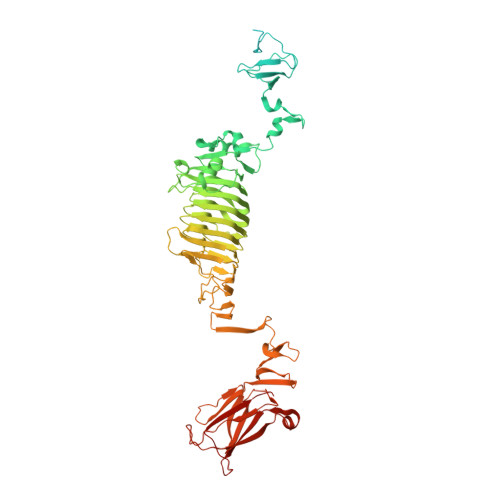Structural basis for fragmenting the exopolysaccharide of Acinetobacter baumannii by bacteriophage Phi AB6 tailspike protein
Lee, I.M., Tu, I.F., Yang, F.L., Ko, T.P., Liao, J.H., Lin, N.T., Wu, C.Y., Ren, C.T., Wang, A.H., Chang, C.M., Huang, K.F., Wu, S.H.(2017) Sci Rep 7: 42711-42711
- PubMed: 28209973
- DOI: https://doi.org/10.1038/srep42711
- Primary Citation of Related Structures:
5JS4, 5JSD, 5JSE - PubMed Abstract:
With an increase in antibiotic-resistant strains, the nosocomial pathogen Acinetobacter baumannii has become a serious threat to global health. Glycoconjugate vaccines containing fragments of bacterial exopolysaccharide (EPS) are an emerging therapeutic to combat bacterial infection. Herein, we characterize the bacteriophage ΦAB6 tailspike protein (TSP), which specifically hydrolyzed the EPS of A. baumannii strain 54149 (Ab-54149). Ab-54149 EPS exhibited the same chemical structure as two antibiotic-resistant A. baumannii strains. The ΦAB6 TSP-digested products comprised oligosaccharides of two repeat units, typically with stoichiometric pseudaminic acid (Pse). The 1.48-1.89-Å resolution crystal structures of an N-terminally-truncated ΦAB6 TSP and its complexes with the semi-hydrolyzed products revealed a trimeric β-helix architecture that bears intersubunit carbohydrate-binding grooves, with some features unusual to the TSP family. The structures suggest that Pse in the substrate is an important recognition site for ΦAB6 TSP. A region in the carbohydrate-binding groove is identified as the determinant of product specificity. The structures also elucidated a retaining mechanism, for which the catalytic residues were verified by site-directed mutagenesis. Our findings provide a structural basis for engineering the enzyme to produce desired oligosaccharides, which is useful for the development of glycoconjugate vaccines against A. baumannii infection.
Organizational Affiliation:
Institute of Biochemical Sciences, National Taiwan University, Taipei 106, Taiwan.





















